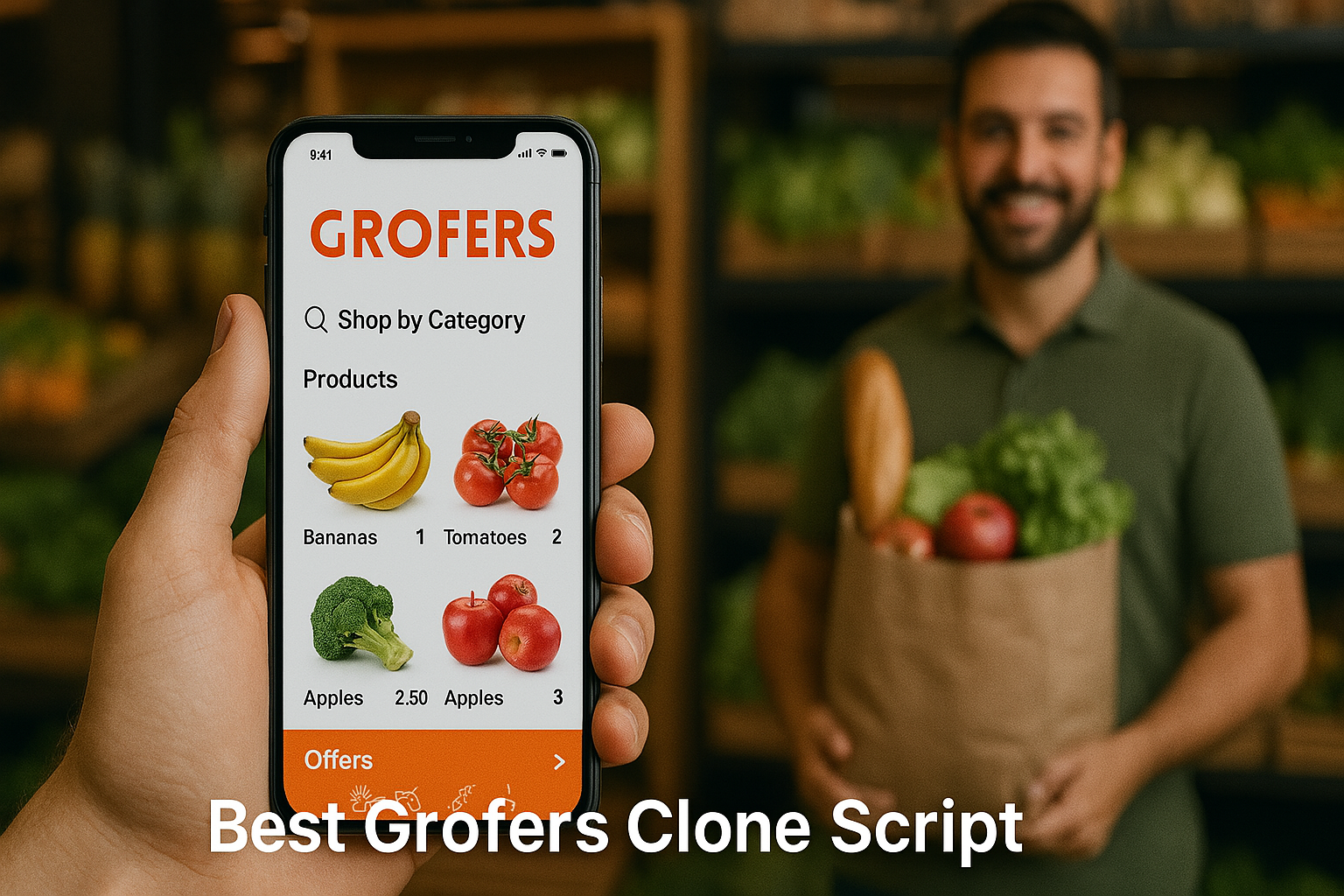Introduction
The grocery delivery industry has witnessed an exponential rise in demand, leading to the emergence of platforms like Grofers. A Grofers clone script is a ready-made grocery delivery solution that replicates the features and functionalities of the original app. This script enables entrepreneurs and businesses to launch their own grocery delivery platform with ease, offering customers a seamless shopping experience. With the rise of e-commerce and the growing need for convenience, investing in a Grofers Clone Script can be a lucrative business opportunity.
Key Features of an Ideal Grofers Clone
An ideal Grofers clone script should encompass the following essential features:
- User-friendly Interface – A seamless and intuitive UI/UX ensures customers can easily navigate through the app and place orders efficiently.
- Advanced Search and Filter – Enables users to search for grocery items by category, brand, or price range.
- Multiple Payment Options – Supports credit/debit cards, UPI, digital wallets, and COD to offer a variety of payment choices.
- Real-time Order Tracking – Provides live updates on order status and estimated delivery time.
- Push Notifications – Keeps customers informed about order status, discounts, and offers.
- Inventory Management System – Helps vendors and store owners manage stock efficiently.
- Multi-vendor and Single-vendor Support – Allows businesses to choose between a multi-store marketplace model or a single-store setup.
- Subscription Plans & Loyalty Programs – Encourages customer retention with rewards and exclusive benefits.
- Admin Dashboard – Offers real-time analytics, sales reports, and user management tools.
- Multi-lingual & Multi-currency Support – Expands business reach by catering to diverse demographics.
Why Invest in a Grocery Delivery App?
Investing in a grocery delivery app like Grofers can be beneficial for the following reasons:
- Increasing Market Demand – The global online grocery market is expanding, offering a profitable opportunity for new entrants.
- Convenience Factor – Customers prefer online grocery shopping due to time-saving benefits and doorstep delivery.
- Recurring Revenue Model – Monetization through commissions, subscriptions, ads, and premium listings ensures steady income.
- Pandemic-driven Digital Shift – Post-pandemic consumer behavior has shifted towards online grocery shopping.
- Scalability & Expansion – A well-developed grocery app can expand across different regions, partnering with local vendors and supermarkets.
How to Develop a Grofers Clone Script?
Developing a Grofers clone script involves multiple stages:
- Market Research – Analyze competitors, target audience, and latest trends in online grocery shopping.
- Define Business Model – Choose between an aggregator model, hyperlocal delivery, or a direct store-to-customer approach.
- UI/UX Design – Create an intuitive and visually appealing user interface to enhance customer experience.
- App Development – Build the app with robust front-end and back-end technologies (discussed in the next section).
- Testing & Debugging – Conduct thorough testing to ensure smooth app performance and fix bugs.
- Launch & Marketing – Deploy the app on Android, iOS, and web platforms with strong marketing campaigns.
- Continuous Updates – Regularly update the app to introduce new features and improve security.
Tech Stack for Grocery App Development
A powerful technology stack is essential for building a high-performing Grofers clone app:
1. Frontend Development (User Interface – UI/UX)
The frontend of a grocery app must be visually appealing and user-friendly. Choose from:
- React Native or Flutter – Cross-platform development for both iOS and Android.
- Swift (iOS) & Kotlin (Android) – Native app development for better performance.
- HTML, CSS, JavaScript (for Web App) – Ensures smooth browsing experience.
2. Backend Development (Server-Side Logic)
A powerful backend handles user requests, payments, and inventory updates. Popular options include:
- Node.js with Express.js – Fast, scalable, and widely used for real-time applications.
- Django (Python) or Ruby on Rails – Secure and efficient for database management.
- Spring Boot (Java) – Reliable for enterprise-grade grocery apps.
3. Database Management
To store product listings, user data, orders, and transactions securely:
- PostgreSQL or MySQL – Structured database for large datasets.
- MongoDB – NoSQL for flexible and scalable storage.
- Firebase Firestore – Real-time database for quick data synchronization.
4. Payment Gateway Integration
A seamless and secure payment system is crucial for a grocery app. Options include:
- Stripe & PayPal – Secure and widely accepted.
- Razorpay or PayU – Best for Indian markets.
- Google Pay & Apple Pay – Mobile wallet integration for easy checkouts.
5. Cloud Services & Hosting
Reliable cloud hosting ensures uptime and smooth operations. Top choices:
- AWS (Amazon Web Services) – Scalable and cost-effective.
- Google Cloud Platform (GCP) – AI & ML integrations for smart recommendations.
- Microsoft Azure – Ideal for enterprise-level security.
6. APIs & Third-Party Integrations
Enhancing features with third-party APIs improves user experience:
- Google Maps API – For location tracking and delivery optimization.
- Twilio or Firebase Cloud Messaging (FCM) – SMS and push notifications.
- Chatbots (Dialogflow, IBM Watson) – AI-powered customer support.
Monetization Strategies
To generate revenue from your Grofers clone app, consider these monetization strategies:
1. Commission-Based Revenue Model
Charge commission fees from vendors or grocery store partners on each order placed through the platform. You can set different commission rates based on product categories or store sales volume.
2. Subscription Plans for Vendors
Offer premium membership plans to grocery stores for added benefits such as:
- Better visibility on the platform
- Reduced commission fees
- Exclusive promotions
This model ensures consistent recurring revenue for your business.
3. Delivery Charges
Implement dynamic delivery charges based on:
- Distance between the store and customer
- Order value (free delivery above a certain amount)
- Peak hour surcharges
Optimizing delivery pricing can significantly boost profits.
4. Advertisements & Featured Listings
Allow grocery stores and brands to advertise their products on your platform via:
- Sponsored listings (higher search rankings)
- Banner ads on the homepage/app
- Discounted promotions to increase sales
5. Affiliate Marketing & Partnerships
Collaborate with third-party brands and affiliate partners to promote complementary products, including:
- Kitchen appliances
- Meal kits
- Household essentials
Earn a commission per sale generated through your platform.
6. White-Label & SaaS Model
If you own the Grofers clone script, you can monetize by:
- Selling custom-branded grocery apps to businesses
- Offering a SaaS-based solution with monthly or yearly subscriptions
This strategy expands your revenue streams beyond just grocery orders.
SEO Optimization Tips for Grocery Apps
Effective SEO optimization ensures higher visibility and organic traffic:
- Keyword Research – Use tools like Google Keyword Planner to identify high-search volume keywords.
- On-page Optimization – Optimize title tags, meta descriptions, and URLs with relevant keywords.
- Content Marketing – Publish blogs on grocery trends, recipes, and shopping tips.
- Local SEO – Optimize Google My Business profile and encourage customer reviews.
- Mobile Optimization – Ensure fast loading speeds and responsive design for mobile users.
- Social Media & Backlinks – Leverage social media marketing and guest blogging to build backlinks.
Conclusion
Launching a Grofers clone app is a promising venture in the growing online grocery industry. With the right features, technology, and monetization strategy, businesses can create a successful grocery delivery platform. If you’re looking to develop a custom grocery delivery app, get in touch with our expert development team today and turn your idea into reality





